#high holy days 5705
Text
High Holy Days, 1944: Scenes from the liberation of Europe: Germany
From The Jewish Chronicle, October 6th, 1944:
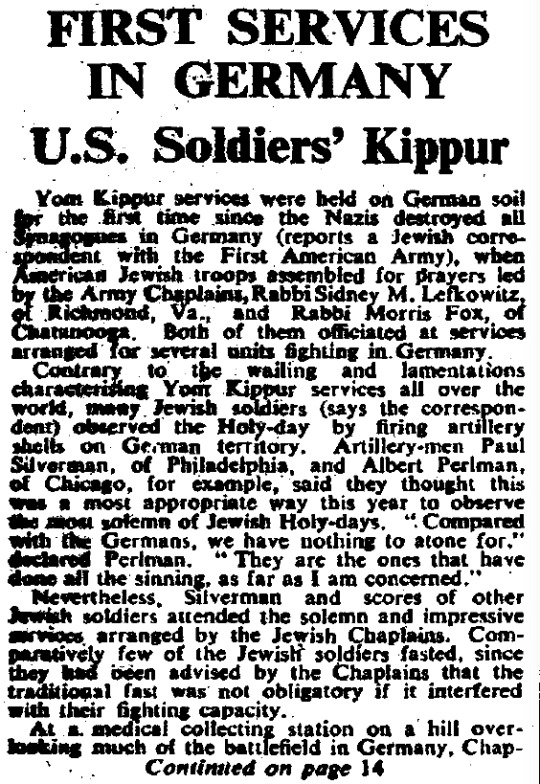



Sidney M. Lefkowitz was born in New York City in 1908. He was an alumnus of the University of Cincinnati and in 1933 received his ordination from Hebrew Union College, which tells us that he was a Reform rabbi. Prior to joining up in May 1942, he served Congregation Beth Ahava in Richmond, Virginia. He was still in the army in late 1945 and by that time had achieved the rank of Captain and been awarded the Bronze Star. Earlier in 1944, he had participated in the liberation of the Nordhausen concentration camp; a few weeks after the article above was published, he was involved in this historic broadcast. (In the photograph, I suspect he's the man facing the camera in glasses and what looks like an Army-issue prayer shawl.) It's a bit odd that he is everywhere described as being "from" Richmond, but after his discharge he did return to the South, serving Congregation Ahavath Chesed, in Jacksonville, Florida, and also teaching at Jacksonville University. He died in 1997.
There is no rabbi named either Fox or Fuchs in the list of Jewish WWII chaplains published in the 1945-46 edition of the American-Jewish Yearbook, and I've been unable to find anything anywhere about a Rabbi Morris Fox.
14 notes
·
View notes
Text
The High Holy Days, 1944: Meanwhile, back in the U.K., there's still a need to provide for “uninvited guests” of various sorts
To begin with, not all evacuees had returned to their homes; indeed, v-weapon attacks had led to a new round of evacuations from London and the South and East Coasts. They needed community and hospitality, as a letter in the September 8th Jewish Chronicle noted:

The improvised "membership groups" that had been organized in places with large-ish numbers of evacuated Jewish households remained active:
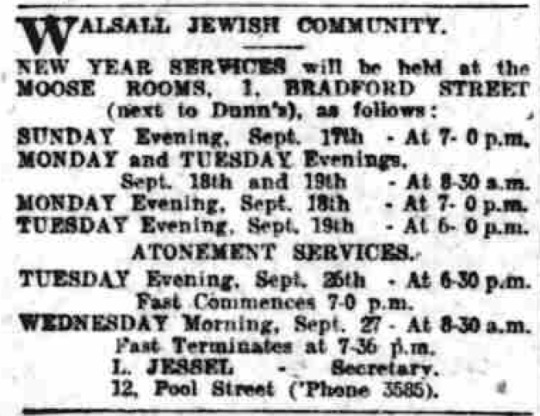

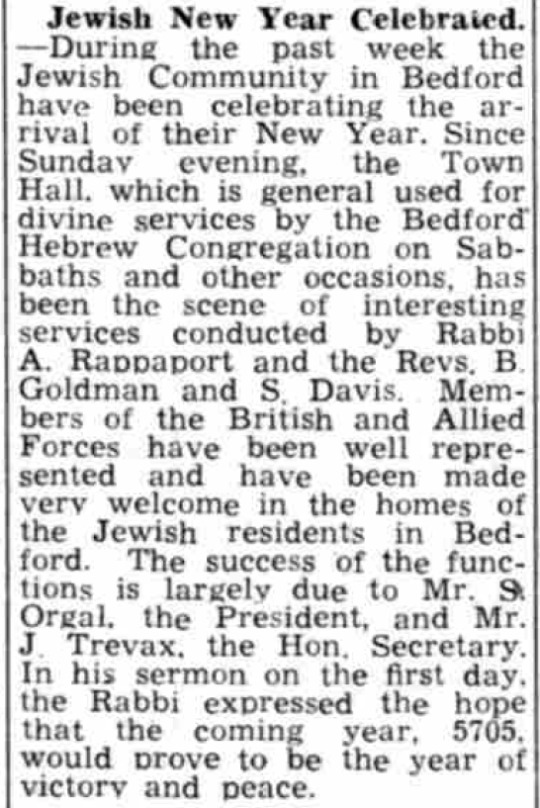
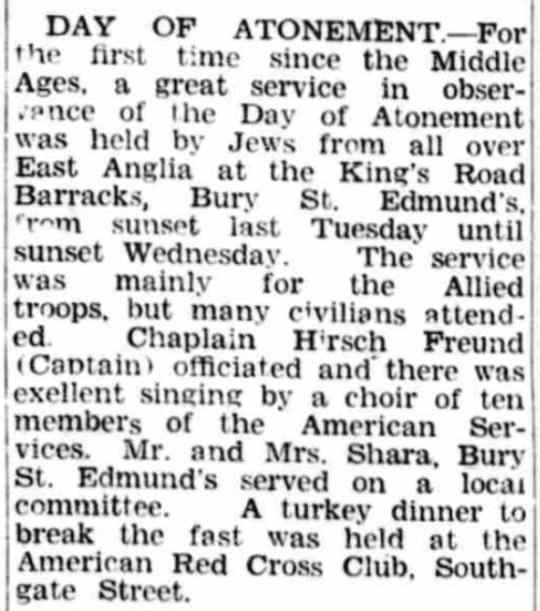
(Above, top to bottom, from the Walsall Observer, September 16th; the Welsh Gazette, September 21st; the Bedfordshire Times & Standard, September 22nd; and the Biggleswade Chronicle, September 22nd. These four images and the final image in this post are ©The British Library Board. All Rights Reserved.)
As noted in the last two items above, there were still some Allied service personnel in Britain, no doubt feeling restless, restive, or both. Two additional letters in The Jewish Chronicle, published as early as August 25th (top), and another on September 8th, appealed for support on their behalf:
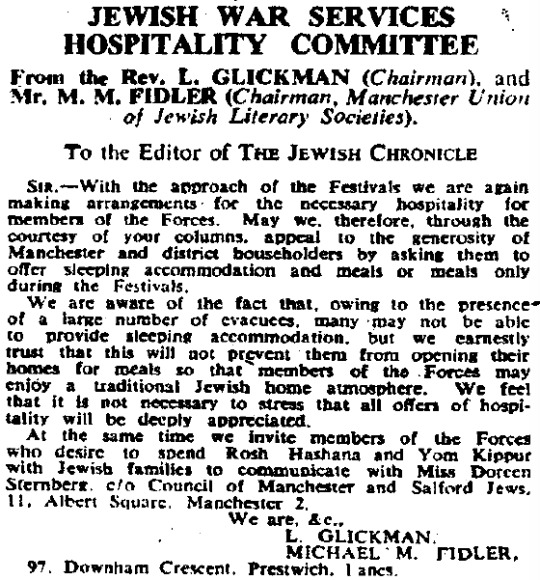
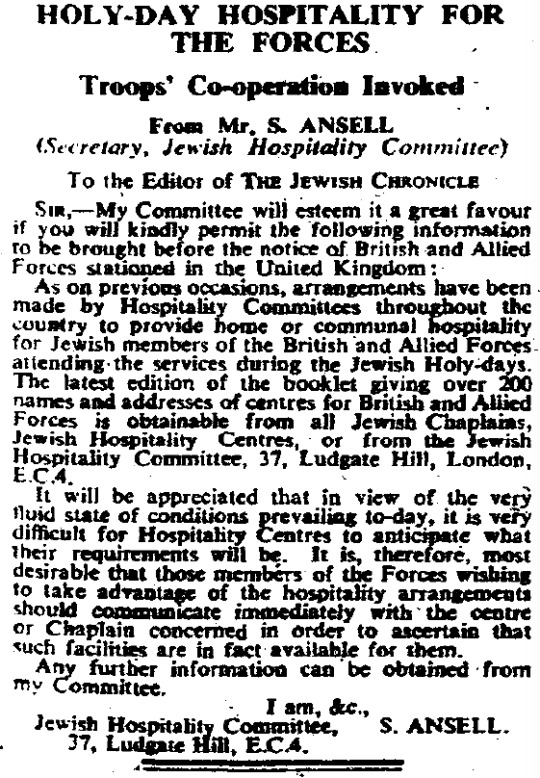
The hospitality provided did not go unacknowledged (even if it sometimes took a while for this to happen 🙄). This is from The Jewish Chronicle's December 15th issue:
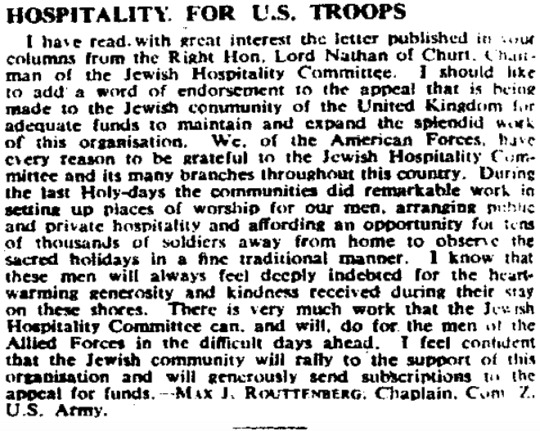
Major Max Jonah Routtenberg (1909-1987) was born in Montreal, P.Q., Canada, and came to the U.S. in 1927. He graduated from New York University before studying for the rabbinate at the Jewish Theological Seminary (telling us that he was Conservative). He served Kesher Zion Synagogue in Reading, Pennsylvania, prior to his induction in late 1942. I am unclear as to when he left the Army, but he returned to Kesher Zion until 1948, when he began filling a series of posts in Conservative Judaism's administrative structure. He returned to the pulpit in 1954, serving Temple B'nai Sholom, Rockville Center, N.Y., until he retired in 1972.
And finally, both Jewish and local history was still being made in at least a few places, as the Bury Free Press recorded on September 30th:

2 notes
·
View notes
Text
The High Holy Days, 1944: Scenes from the liberation of Europe: Netherlands and Belgium
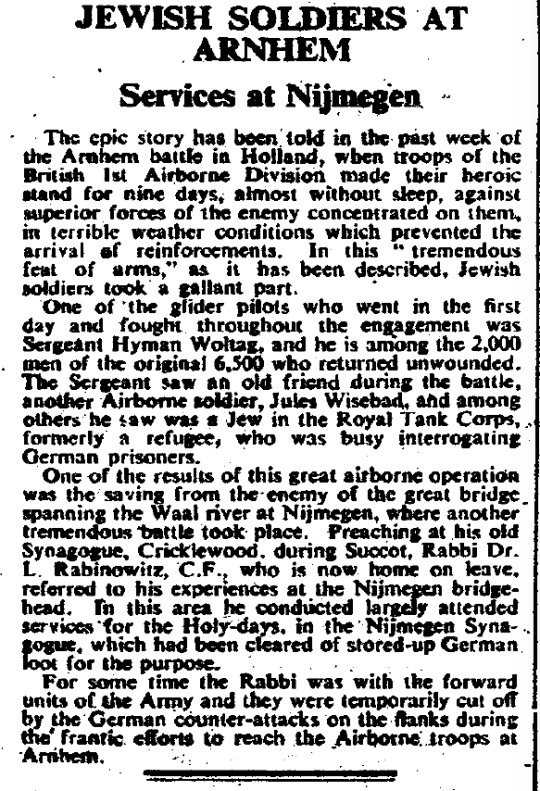
Above, from The Jewish Chronicle, October 6th, 1944.
Two weeks later, The JC published the following:
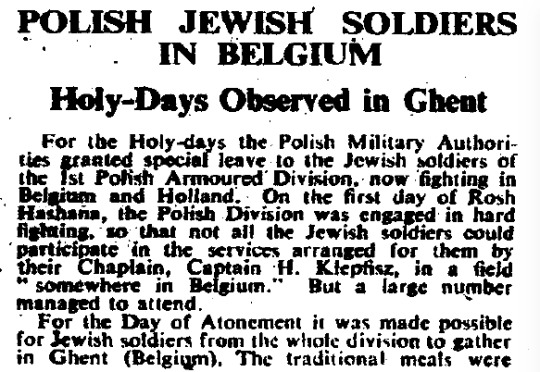
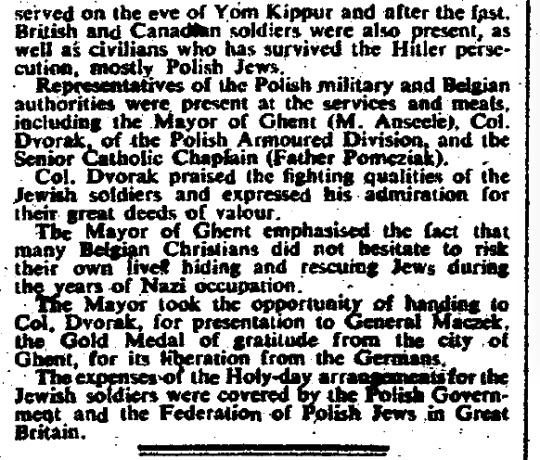
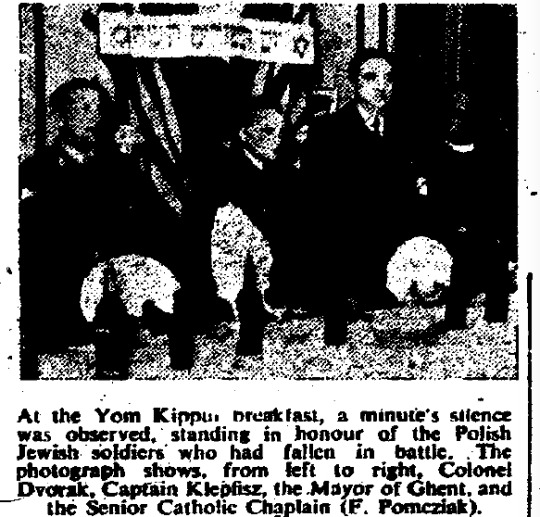
3 notes
·
View notes
Text


The High Holy Days, 1944: Scenes from the liberation of Europe: France
Top, First Lt. Arthur H. Saffe leads Yom Kippur services at the synagogue in Verdun. (He doesn't appear to have been a chaplain, which is perfectly fine; in the end, we don't need no stinkin' chaplain! Also, I really love this photo. The women, whatever their charge may have been, are front and center!)
Below, 329th Infantry personnel at a Rosh Hashanah service held somewhere between Beaugency and Orleans.
From The Jewish Chronicle, September 29th:
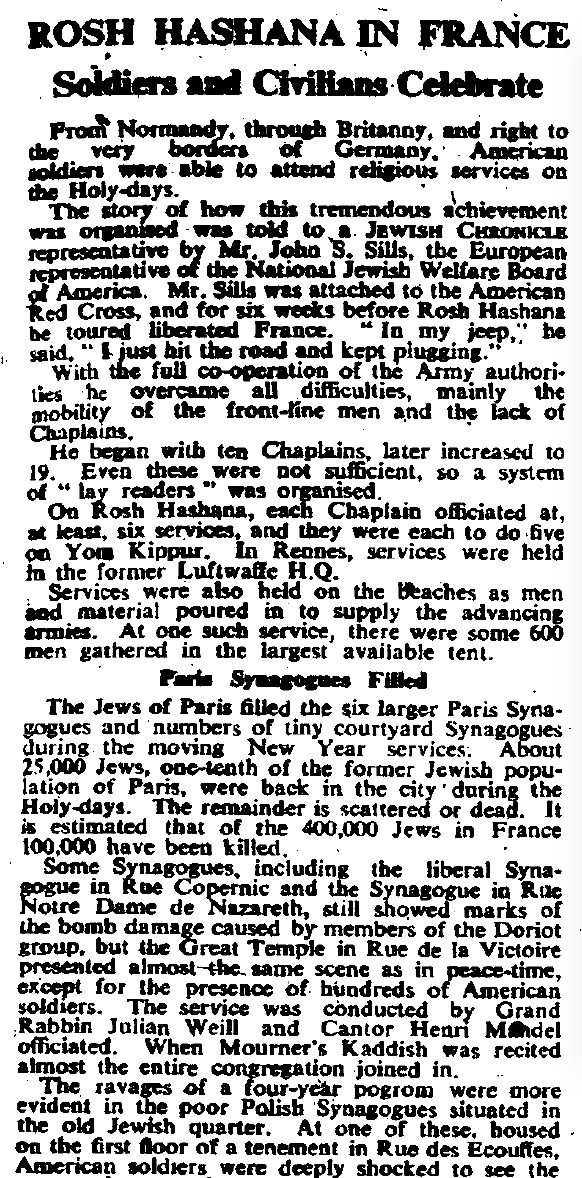

("It is estimated that of the 400,000 Jews in France 100,000 have been killed." What no one ever seems to mention is that this is a considerably higher survival rate than was the case in most occupied countries, and that this was accomplished with the help of thousands of non-Jews who took tremendous risks in order to protect their Jewish fellow citizens.)
From the biographical sketch in the finding aid to the Morris N. Kertzer Papers at the American Jewish Archives:
Rabbi Morris Kertzer was born on October 18, 1910 in Cochrane, Ontario. He received his bachelor’s degree from the University of Toronto and his master’s degree from the University of Illinois. He then studied under Mordecai Kaplan at the Jewish Theological Seminary where he earned a doctorate in Hebrew literature and he was ordained in 1934. Rabbi Kertzer would eventually separate from the Jewish Conservative movement to join the Reform rabbinate.
Kertzer served congregations in Illinois, Alabama, and Iowa before joining the army to serve as a Jewish Chaplain in World War II. During World War II Rabbi Kertzer was the only Jewish Chaplain at the Anzio beachhead, earning a bronze star for his services there. He entered Rome shortly after the liberation and spoke at the liberation ceremonies. He also served in Africa as well as Southern and Central France before returning home in 1945.
Rabbi Kertzer was active in Jewish-Christian relations, earning the International University of Rome’s Pro Deo Medal for promoting understanding between Catholics and Jews. He traveled internationally lecturing in Italy, Rumania, Japan, Turkey, India, Thailand and Israel. Rabbi Kertzer authored several books including With an “H” on my Dog Tag, his memoirs as military chaplain in World War II, What is a Jew?, (which went into more than 30 printings), Today’s American Jew, Tell me Rabbi, and The Art of Being a Jew. He also published numerous articles.
Rabbi Kertzer led the first Jewish delegation to the Soviet Union in 1956 and subsequently won the George Washington Medal for his analysis of the Soviet Union’s anti-Semitism. He served as the national president of the Jewish Military Chaplains Association, he was the national chaplain of Amvets and was the chairman of the social action commission of the Synagogue Council of America (1950’s), secretary of the New York Board of Rabbis (1957-1959), member of the executive board of the CCAR (1964-1966), and trustee of the Union of American Hebrew Congregations (1962-1967). He served as Rabbi in Larchmont, then in Riverdale, New York in the 1960’s and 1970’s. He retired in Scottsdale, Arizona where he taught at Mesa Community College, and was a member of the Jewish Federation of Greater Phoenix. He passed away on December 29, 1983.
2 notes
·
View notes
Text

The High Holy Days, 1944: Serious matters
"What's happy about this New Year?"
That was the headline of a large display advertisement that ran in the September 23rd, 1944, issue of The New York Times. It may sound like a killjoy's whine, but in fact it was a highly appropriate question. Despite Allied advances in Europe, the mood of the Jewish public was somber. What Allied troops were encountering in the liberation of the concentration camps was far worse, I think, than what even the most pessimistic had anticipated.
On both sides of the Atlantic, there was growing Jewish anger at the Roosevelt administration for having failed to take action that might have hindered the Final Solution (such as the bombing of railroad tracks in Germany and Nazi-occupied countries) and, in particular, at the Churchill government for effectively closing off Mandate Palestine to Jewish refugees (a policy that was continued under the Atlee government).
This latter state of affairs had been a focus of public attention since at least April, as described in this article printed in the B'nai B'rith Messenger (Los Angeles) on April 14th:
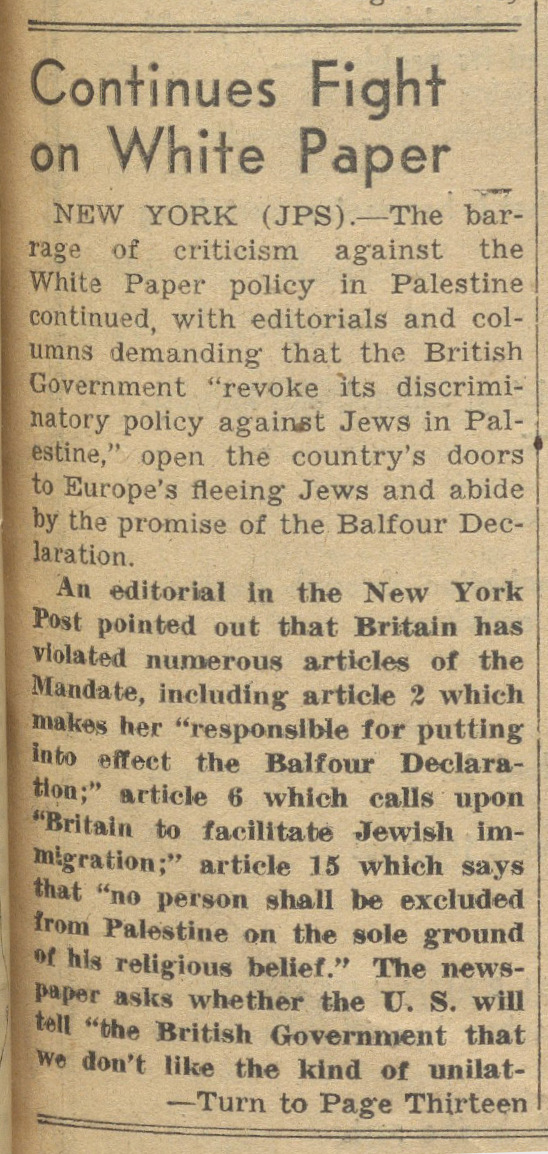
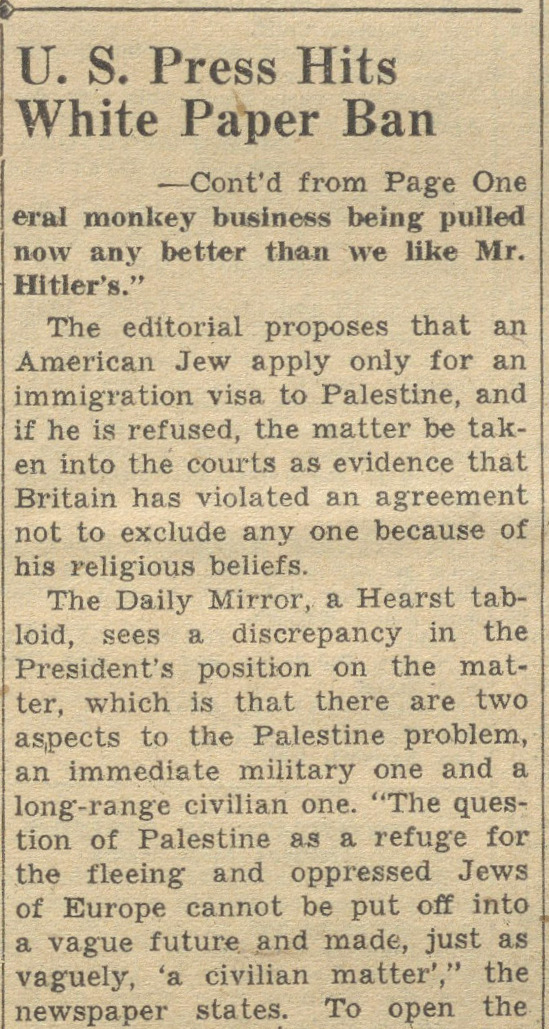

The issue resurfaced in late August, as described in The Sentinel (Chicago) on August 31st:
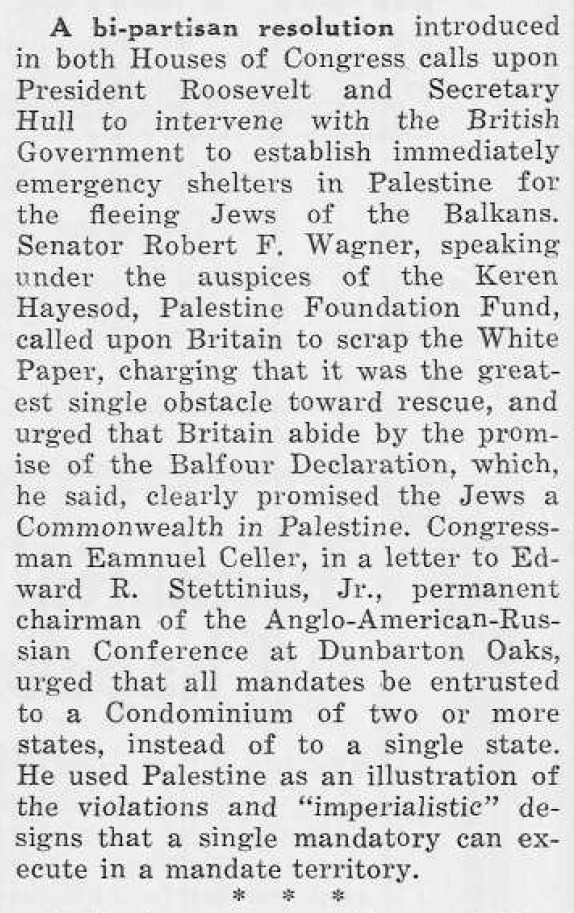
In very slightly more oblique terms, Rabbi Joseph H. Hertz, Chief Rabbi of the United Hebrew Congregations of the British Empire, put this at the center of his annual New Year message, which was printed in The Jewish Chronicle (London) on September 15th:
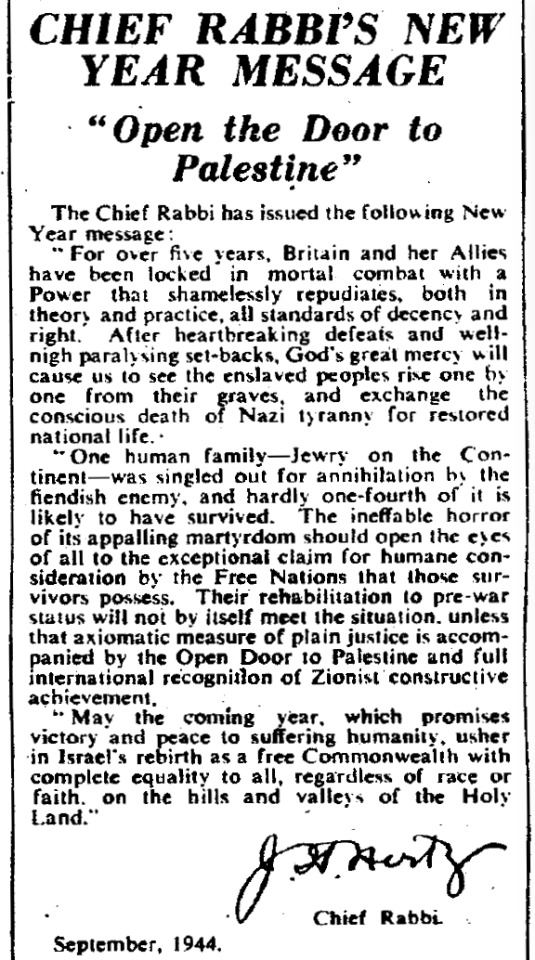
(Oddly enough, this corresponds almost exactly with the excerpt from his overseas broadcast of September 17th that was transcribed in the next day's New York Times. It's rather surprising to see such language printed in the Times of that period; it was a solidly anti-Zionist paper at that point.)
The situation came up again during the first week of October — or at any rate that happened in the Jewish press. I've been able to find barely a word on the topic in the general press, in either the U.S. or the U.K. For that reason, I'm including here the most detailed account I've found, in its entirety, from The Sentinel's October 5th issue:


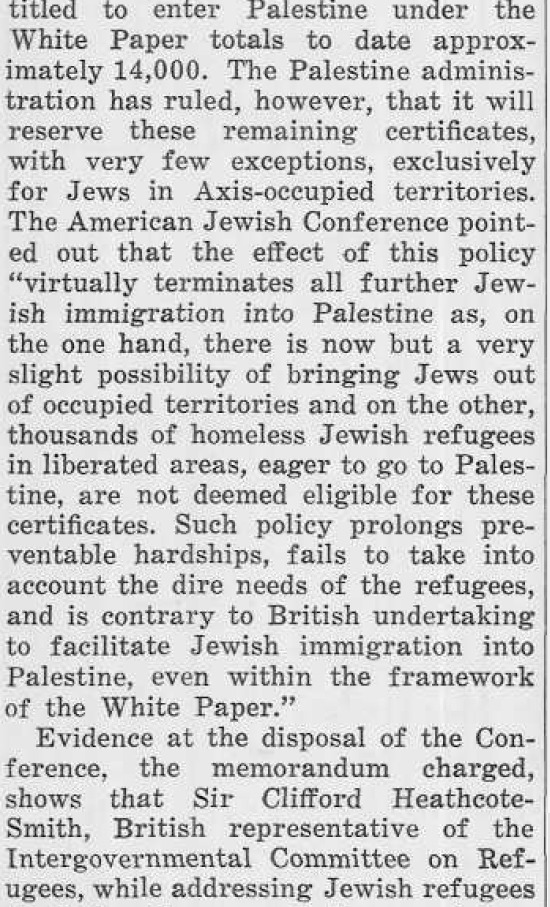


Meanwhile, here is the remainder of the ad with whose headline I began this post:
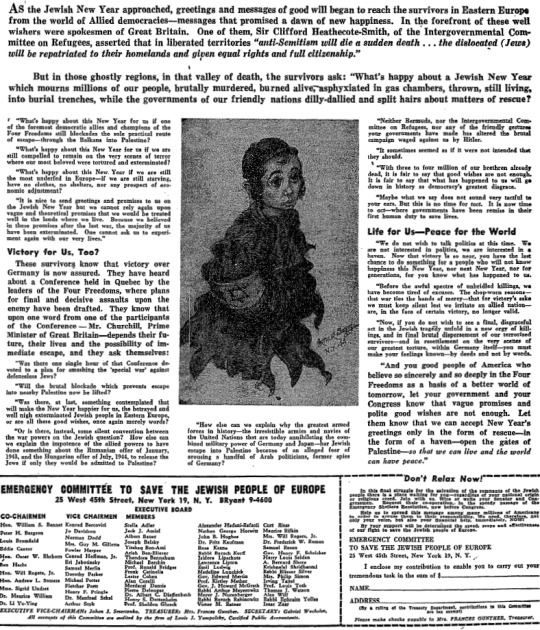
(The illustration is by Arthur Szyk. To enlarge the clipping so that you can actually read it... well, you know the drill, I'm sure.) The organization that placed this ad, the Emergency Committee to Save the Jewish People of Europe, was highly controversial in the wider American Jewish community (despite involvement of a large number of VIPs), due to their aggressive lobbying tactics, lack of transparency regarding finances, and apparent unwillingness to distance themselves from the activities of the Irgun, the Stern Gang, etc.
The Emergency Committee also seems not to have joined in the widespread American Zionist disavowal of the idea the goal of Zionism was to have all Jews — even American Jews — begin new lives in the Land of Israel, thus ending (presumably inevitable) Jewish suffering in the Diaspora. And maybe, just maybe, they were onto something. The following is from the New York Herald-Tribune, September 27th, 1944:
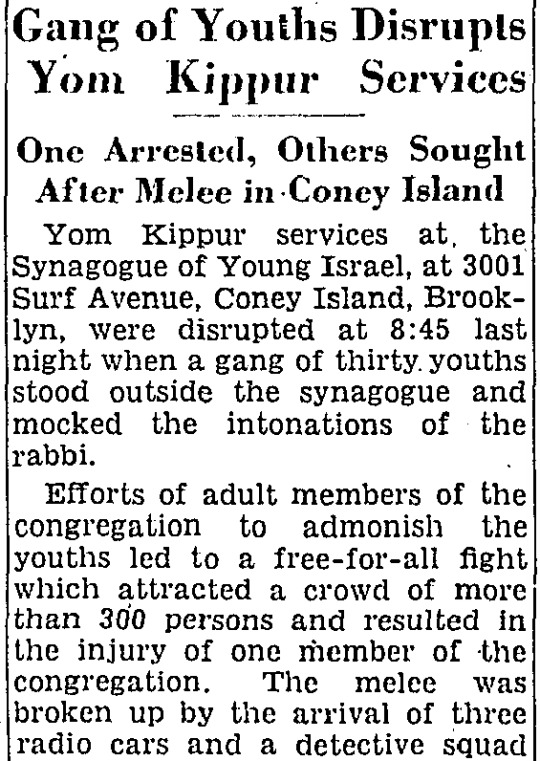

Sounds rather contemporary, when you think about it.
#world war ii#jewish experience#international relations#high holy days 5705#high holy days 5784#long post#very very long in fact#you'll need to carve out some time for this one
1 note
·
View note
Text
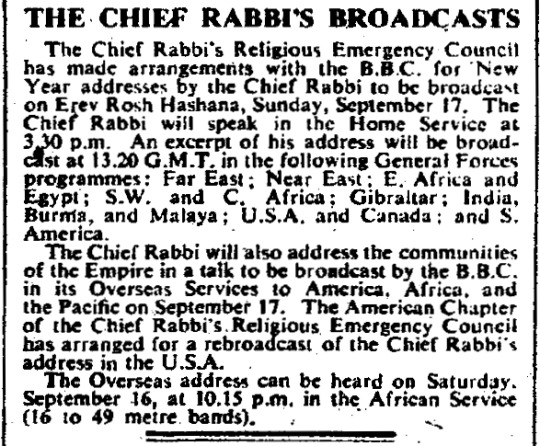
The High Holy Days, 1944: on the air
(above, from The Jewish Chronicle, September 15th, 1944)
This appears to have been the first time that the Forces Programme carried Jewish content of any kind. Both broadcasts were duly noted in the September 15th issue of Radio Times:
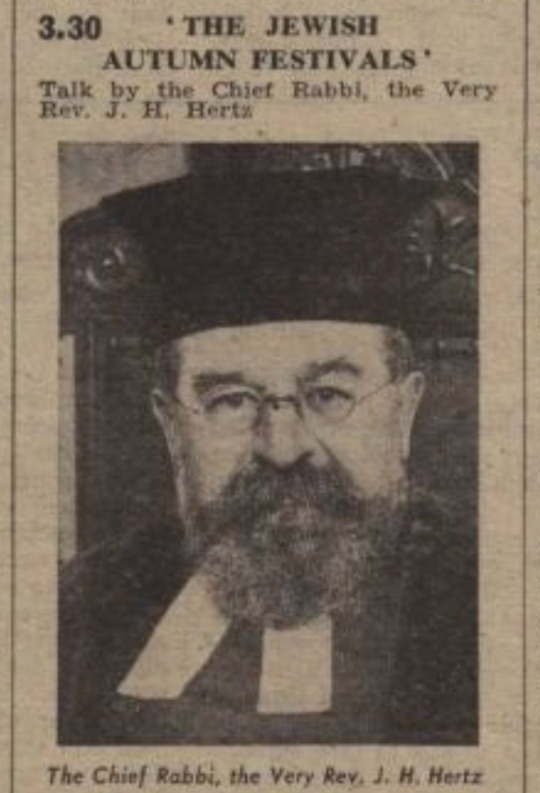

As you can see, the Forces broadcast actually took place before that on the Home Service, and it was a very brief excerpt. (The Home Service program was 15 minutes.) However, it had tremendous reach! Here's an item from The Jewish Chronicle's September 22nd issue:
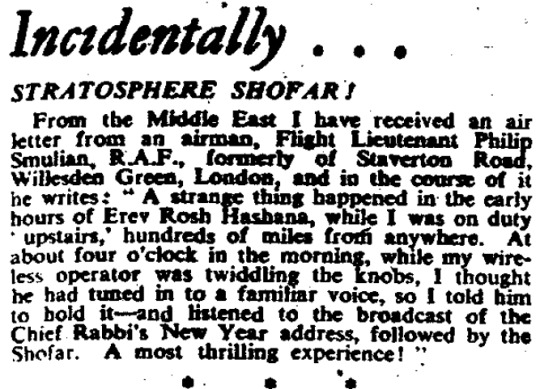
The American broadcast also generated a good deal of excitement (more about this in a few days), and it seems to have taken the wind out of the sails of American broadcasters. There was this, as noted in the New York Herald-Tribune on September 27th:
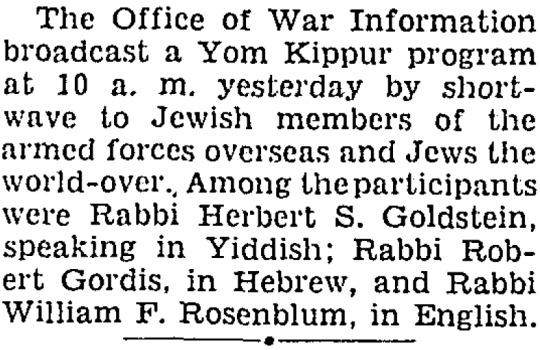
... but the only domestic broadcast, either local or national, that I've been able to find was ... well, here's a description of it in The Sentinel (Chicago) on September 14th:

The sum total of what I've been able to learn about Ada Jackson can be found here, and I haven't been able to discover who the "prominent actress" turned out to be. (I'm hoping for Sylvia Sidney or Paulette Goddard.) If anyone has any further information, Please reblog this and share what you know!
1 note
·
View note
Text

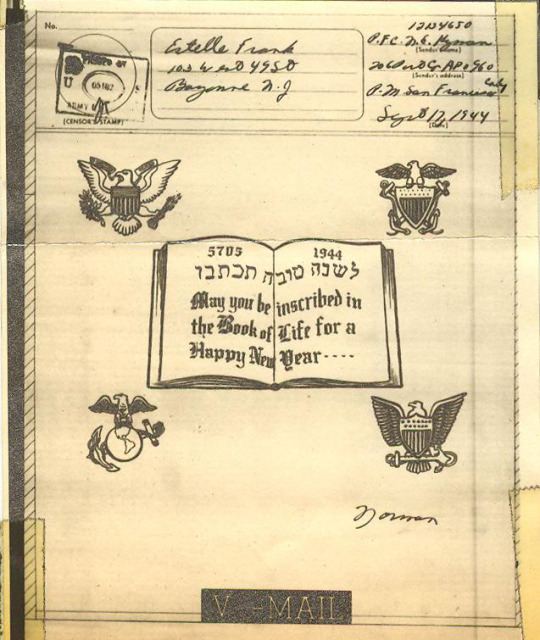

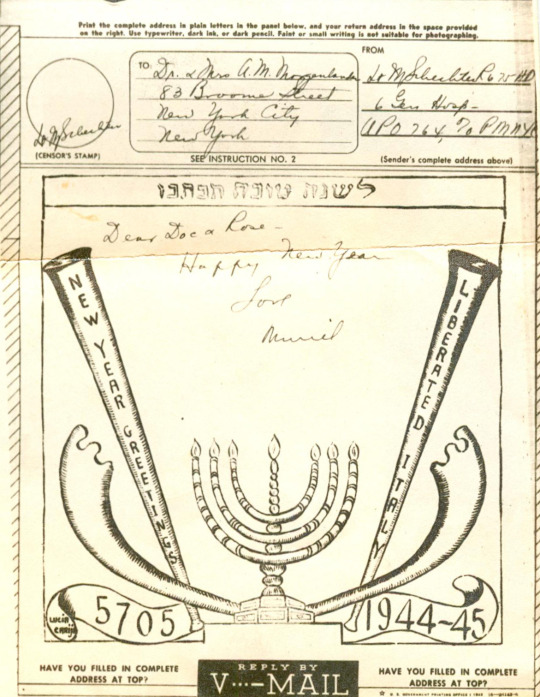

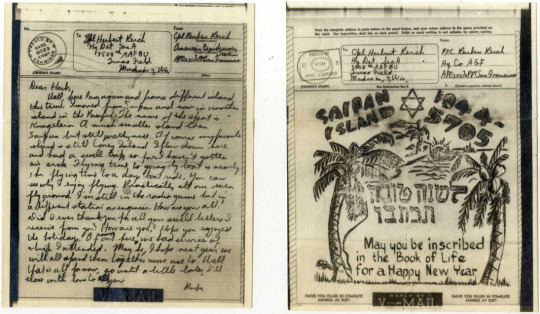
Above, six examples of Rosh Hashanah V-letters for U.S. troops. Many of them appear to have been designed and printed for the use of personnel in a specific location, and all of them are dated 1944. I haven't seen anything like these for any Jewish holiday in previous years of the war.
I've also found one seasonal airgraph for use by British troops:
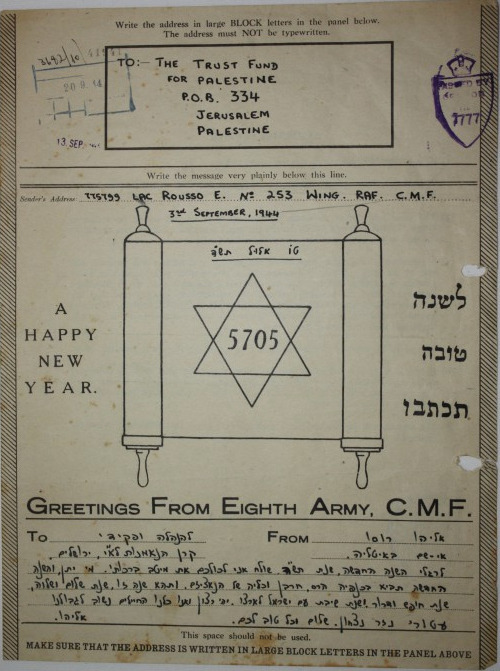
It, too, is from 1944.
Earlier in the war, the Jewish Welfare Board had distributed holiday postcards to American Jewish troops. This year, for the first time, British troops had access to such a card, as noted in this very badly scanned clipping from The Jewish Chronicle's September 8th issue:
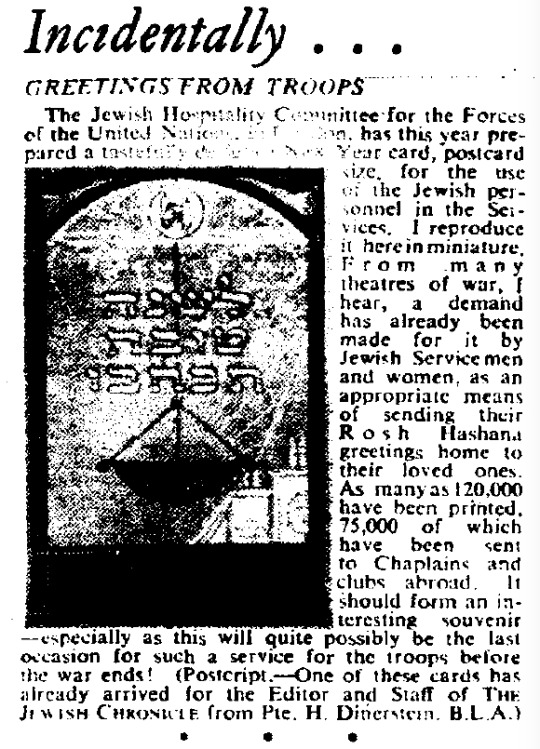
And, lo and behold, here it is in real life:

9 notes
·
View notes
Text
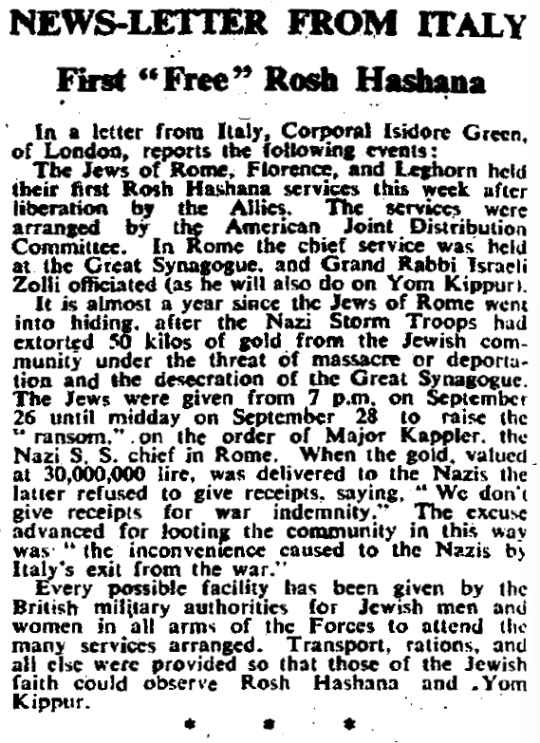
The High Holy Days, 1944: Scenes from the liberation of Europe: Italy
(above, from The Jewish Chronicle, September 22nd, 1944)
On September 18th, The New York Times had published a more detailed account of the services in Florence and Rome (Cpl. Green appears to have been confused about the location):
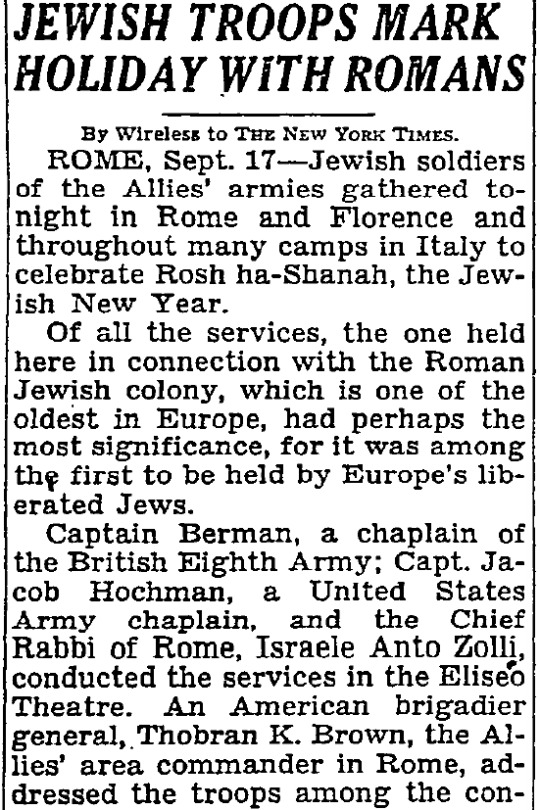

Aaron Paperman was born in Baltimore, Maryland, in 1914, and received his ordination in 1937 from the Rabbinical College of Telshe, Lithuania (a credential that marks him as ultra-Orthodox). Prior to joining up in September, 1942, he served the Orthodox Jewish Congregation of Plainfield, New Jersey. He was still in the Army in late 1945, by which time he had been promoted to Major and awarded the Bronze Star. He remained in Italy for some time with the Army of the Occupation, working with the residents of a displaced persons camp near Rome. I've had some trouble tracing his later movements, but he apparently spent at least a few years back in Baltimore before moving permanently to Israel, where he died in 2002.
Here is Rabbi Paperman, with Rabbi Zolli, at a service that was, in fact, held at the Great Synagogue of Rome (and broadcast), on July 31st:
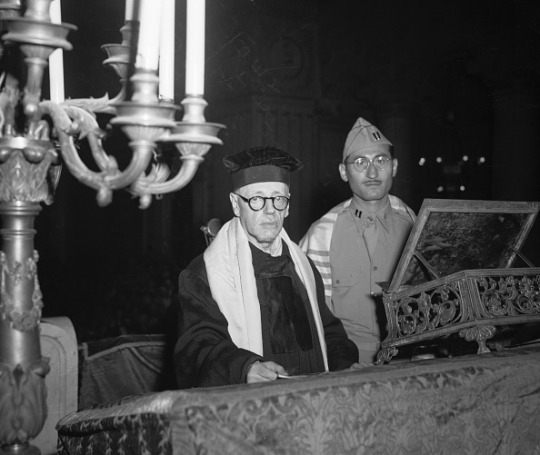
The Rome Rosh Hashanah service drew special attention on September 19th from Rabbi Hochman's hometown paper, the Boston Globe (Chelsea is a small city just outside Boston):
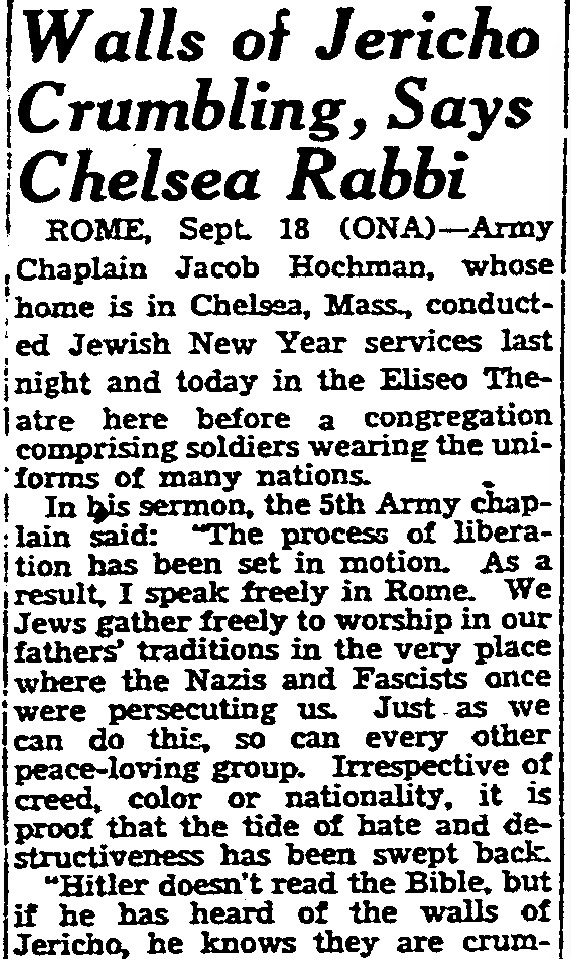
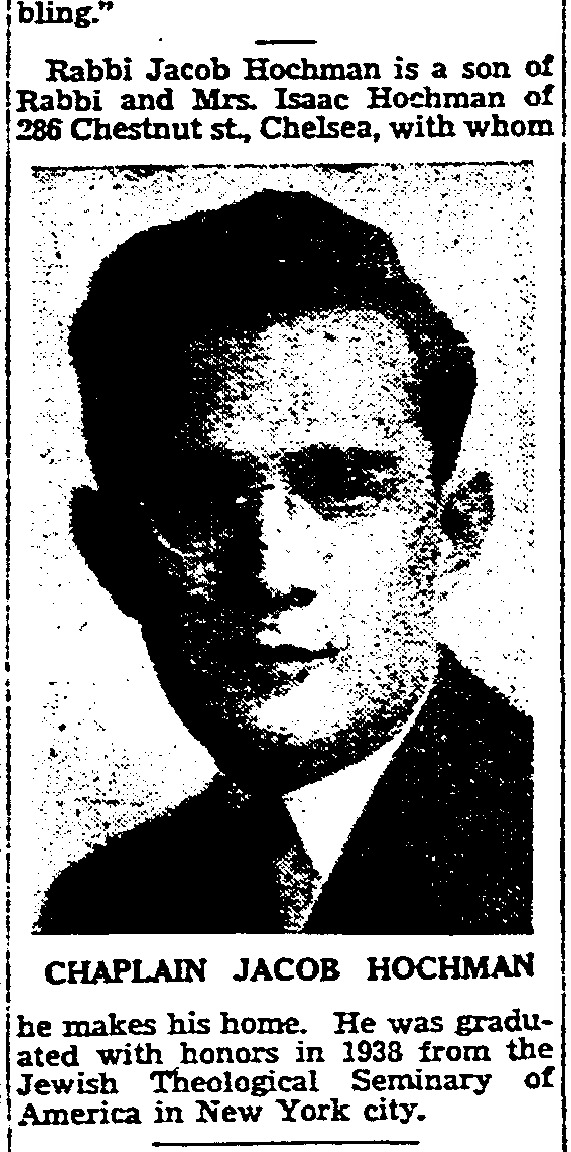
Jacob Hochman was born in Poland in 1913 and was came to the United States in 1921. He was an alumnus of Yeshiva University, which suggests that his upbringing was Orthodox, but in 1938 he received ordination from from the Jewish Theological Seminary, which trains rabbis for the Conservative movement. Prior to his induction in January 1943 he served a congregation in Pottsville, Pennsylvania. He was stationed in North Africa for a time before arriving in Italy, and was still in the Army towards the end of 1945. After his discharge he served congregations in Roslyn, N.Y., Los Angeles, and Milton, Massachusetts (another Boston suburb), before his untimely death in 1966.
3 notes
·
View notes